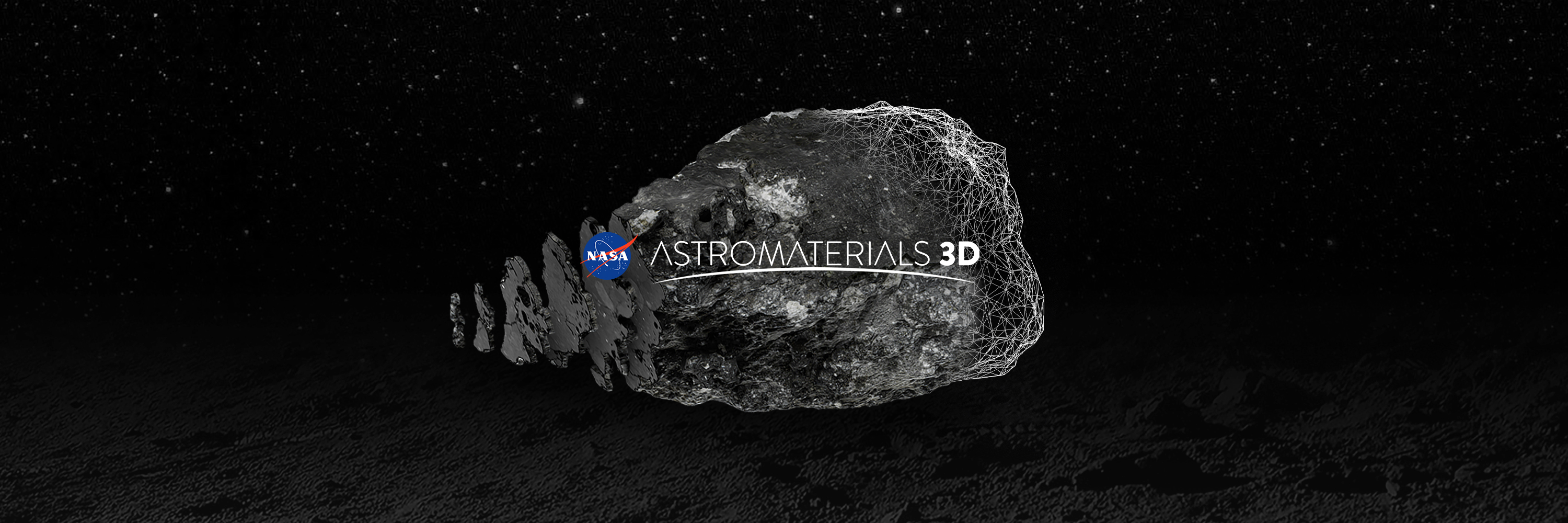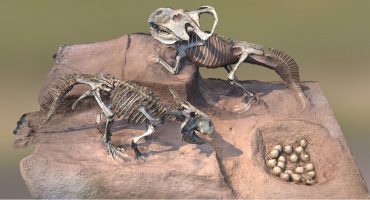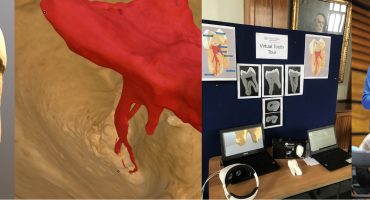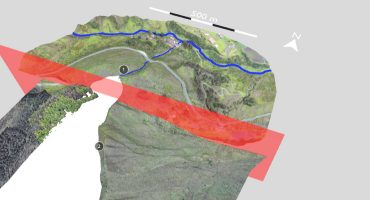Introduction
Hello! My name is Erika Blumenfeld and I am an independent, transdisciplinary artist with a research-based artistic practice. My work focuses on the stories of connection across the cosmos and how these stories intersect with art, science, nature, and culture. At the root of my practice is curiosity and inquiry–I am continually interested in subjects such as natural phenomena, earth science, ecology, geology, planetary processes, astronomy, and cosmochemistry. Through the process of my work, I investigate the incredible knowledge that we are, in our very chemistry, of and from the stars.
I’m thrilled to introduce the Sketchfab community to one of my recent projects, Astromaterials 3D, which is an interactive virtual library of NASA’s Apollo Lunar Samples and Antarctic Meteorite Samples Collections and an information-rich visualization tool for researchers and the general public. This project has evolved as an unprecedented collaboration between art, science, and technology. Nearly a decade in the making, the Astromaterials 3D combines high-resolution precision photography, structure-from-motion photogrammetry and X-ray computed tomography, producing the very first research-grade interactive 3D models of the exterior and interior of NASA’s extraterrestrial samples in a single coordinate system. At its core, Astromaterials 3D intends to provide greater access to NASA’s astromaterials collections and the incredible stories these rocks from space reveal through the study of them.
Welcome to the homepage for Astromaterials 3D: A virtual library for exploration and research of NASA’s space rock collections! [Credit: NASA/Astromaterials 3D]
As Astromaterials 3D’s creator, I have the great privilege of being both the Science-Principal Investigator and Project Lead. Yet, a project of this scale has required an extensive interdisciplinary team at NASA Johnson Space Center that brings together expertise in the fields of art, professional photography, heritage conservation practices, geoscience, astromaterials curation, photogrammetry, imaging science, x-ray computed tomography, application engineering, and data curation. To highlight the brilliant work of my core team: Joseph Aebersold is a 3D Imagery Analyst who produces all of our 3D models, developed our scaling methodology for accurate fusion of structure-from-motion (SFM) and X-ray computed tomography (XCT) imagery, and manages our project data archiving; Ben Feist, Software Engineer, Data Visualization & Informatics, developed our software architecture and Astromaterials 3D Explorer visualization application, handles our data processing and repackaging for online streaming, and website JavaScript programming; David Charney, Visual Designer, developed the visual language and user experience design for the Astromaterials 3D Website and Explorer.
Before I dive into the complexities of how we created this project, I thought I would share a little background about my art practice and how the idea for this project came into being.
Art, science, nature & culture
I’ve been a professional artist for nearly 30 years, and throughout my artistic research, I have been especially curious about the places within our culture-making practices where we see evidence of how humans have sourced meaning from our relationship with our natural world. Whether we reflect on our earliest artworks carved into or painted on rock the world over, survey our eons-long enchantment under the starry night, or peer into the vast microcosm of our body’s biochemistry, we find evidence that both physically and imaginatively, humans derive health and meaning from an active, living connection with our natural world. Nature and culture are inextricably linked. It was this realization that inspired me to study, more intently, the stories and relationships between our natural heritage and cultural heritage. In particular, I was interested in both the scientific rigor and imaginative curiosity that led us to learn that we are made of the same stuff as stars. Remarkably, the knowledge of this cosmochemical lineage arose in great part because of the study of rocks from space—rocks like the ones presented in Astromaterials 3D from NASA’s space rocks collections.
Graphic animation of our 3D model of Apollo Lunar Sample 10022,53, a small rock collected during the Apollo 11 surface mission that was among the very first rocks collected from the Moon. [Credit: NASA/Astromaterials 3D]
Rocks as scrolls of knowledge
I’ve been picking up interesting rocks along shorelines and mountain paths since I was small, always sensing the mysteries held within them. In 2011, my longstanding love of rocks was intensified during an artist-in-residence sailing expedition around the Scottish Isles, where I encountered the majestic basalt pillars and Lewisian gneiss the region is known for, inspiring me to deepen my knowledge of geologic and planetary processes. Ask any geologist about the processes they study and they will nearly always end their explanation with the same mind-dazzling statement: …but, the story is in the rock. I began to think of rocks as scrolls of knowledge that reveal stories of primordial formation. Eventually, a persistent question arose for me: Might it be possible to hold a rock in one’s hands that tells the story of the whole cosmos?
NASA’s space rock collections
While the question to hold such a rock in one’s hands is poetic in nature, it is also true that rocks from space collectively tell the story of how our solar system evolved. My inquiry into how far back in time the story of a rock might be able to take me eventually sparked an idea, leading me to contact NASA in January 2013 to propose the Astromaterials 3D project. To my amazement, they were interested, and I began working on the project with an incredible team at the Astromaterials Research & Exploration Science Division (ARES) at NASA Johnson Space Center. A little over a year later, my team and I had produced the first ever 3D model of a Moon rock. We then were awarded a NASA research grant to pursue the production of the Astromaterials 3D project.
NASA’s Astromaterials Acquisition and Curation Office, part of the ARES Division, houses NASA’s collections of extraterrestrial samples. These collections include samples from the Moon, asteroids, comets, solar wind, and the planet Mars. Being both scientifically and culturally significant, the samples require a unique conservation approach. Government mandate dictates that NASA’s Astromaterials Acquisition and Curation Office develop and maintain protocols for “documentation, preservation, preparation and distribution of samples for research, education and public outreach” for both current and future collections of astromaterials.
My artistic intent with the Astromaterials 3D project is to provide a novel and dynamic way to make NASA’s collections more accessible to researchers and the public—so that these incredible rocks’ formation stories that span our solar system could spark wonder, awe, and stimulate research. My ultimate hope is to give you the opportunity to hold—virtually—these remarkable rocks in your own hand.
Astromaterials 3D: Methodology & technology
Astromaterials 3D is the very first virtual 3D data collection of NASA’s Apollo Lunar and Antarctic Meteorite samples. So, how did we create it?
 The Apollo Lunar Collection homepage displays an interactive view of the Moon where you can select an Apollo landing site and begin your journey discovering a selection of Moon rocks from each of the six surface missions. [Credit: NASA/Astromaterials 3D]
The Apollo Lunar Collection homepage displays an interactive view of the Moon where you can select an Apollo landing site and begin your journey discovering a selection of Moon rocks from each of the six surface missions. [Credit: NASA/Astromaterials 3D] The Antarctic Meteorite Collection homepage displays an interactive view of the inner solar system where you can select an origin, like Vesta or Mars or the asteroid belt and begin your journey discovering a selection of space rocks from each origin. [Credit: NASA/Astromaterials 3D]
The Antarctic Meteorite Collection homepage displays an interactive view of the inner solar system where you can select an origin, like Vesta or Mars or the asteroid belt and begin your journey discovering a selection of space rocks from each origin. [Credit: NASA/Astromaterials 3D]Photographic image capture & processing
Our first step is to take high-resolution precision photography (HRPP). NASA’s astromaterials are housed in a multi-cleanroom facility and have strict curation protocols to protect them for research and posterity. Therefore, the rocks must be kept inside of nitrogen cabinets at all times during the photographic process. There are also restrictions on what materials the rocks can come into contact with, and in most cases they can only come into contact with the following materials: Teflon, stainless steel and certain types of aluminum. Therefore, we could not put a 3D-scanner into the nitrogen cabinet to scan the rocks, as this equipment contains materials that do not meet curation protocols. Instead, we had to develop a method to manually photograph the rocks through the small windows of scientific glass that exist on one end of the cabinet, which is called the Science Observation Port. Using a custom imaging setup, I capture images in increments of 7.5- to 15-degrees in rotation, and at 15-degree elevations, which totals between 240 and 480 angles of each rock. I use high-resolution professional camera systems that range from 60- to 100-megapixel in order to maximize the surface details, and to achieve a final model texture that is “research-grade”. The technique provides images that achieve resolutions as fine as 30 to 60 microns, depending on sample size and camera system implemented. This method provides exceptional detail and reliable fidelity of the rock meant to meet the quality demands of both today’s and future users.
 Erika Blumenfeld and Apollo Sample Curation Processor, Jeremy Kent, preparing a lunar sample for imaging in NASA’s Lunar Laboratory [Credit: NASA/Josh Valcarcel]
Erika Blumenfeld and Apollo Sample Curation Processor, Jeremy Kent, preparing a lunar sample for imaging in NASA’s Lunar Laboratory [Credit: NASA/Josh Valcarcel]X-ray Computed Tomography imaging
Each of the rocks in the Astromaterials 3D project are XCT scanned at either the University of Texas High-Resolution X-ray Computed Tomography Facility (UTCT) or at the Astromaterials Research & Exploration Science CT Laboratory at NASA Johnson Space Center. XCT image data provide a complete 1:1 volume data set of the rock, where brightness variation of textural features is related to its density and composition. These are the images you see inside the rock when you slice through on the Astromaterials 3D Explorer Application.
 Erika Blumenfeld reviewing XCT scans of a lunar sample with collaborators at The University of Texas High-Resolution X-ray Computed Tomography Facility (UTCT) , where most of the samples for this project were scanned. [Credit: UTCT]
Erika Blumenfeld reviewing XCT scans of a lunar sample with collaborators at The University of Texas High-Resolution X-ray Computed Tomography Facility (UTCT) , where most of the samples for this project were scanned. [Credit: UTCT]Generating the interior & exterior 3D models
My colleague Joseph Aebersold does all the modeling and this is a highly manual process. We use SFM software to produce our 3D reconstructions of the HRPP images using photogrammetric principles. The method uses image-processing algorithms and techniques originating in computer vision to resolve 3D models for accurate and detailed visualization of each sample. The software provides a stepwise process that is then manually tailored for each model based on the unique spatial and specular reflectance properties of each rock.
Model “fusion”
The process for registering the coordinate system and combining the SFM model with the XCT data in order to achieve the “fused” 3D model of both data sets went through several stages of development before the final method was achieved, originally developed by our colleague Kevin Beaulieu and then furthered by Joseph Aebersold, who now performs this step as well. The Astromaterials 3D Explorer is a custom-engineered browser-based software application that ingests the exterior (HRPP) and interior (XCT) image data and digitally “fuses” them into a single object.
 A view of Apollo Lunar Sample 65035,0 in the Astromaterials 3D Explorer application, looking into the rock’s interior XCT imagery. [Credit: NASA/Astromaterials 3D]
A view of Apollo Lunar Sample 65035,0 in the Astromaterials 3D Explorer application, looking into the rock’s interior XCT imagery. [Credit: NASA/Astromaterials 3D]The Astromaterials 3D Website & Explorer
The Astromaterials 3D Explorer application was developed by team member Ben Feist and uses a combination of sprite graphics in the browser canvas and on-demand high-resolution downloads. The data is rendered in real-time within the user’s browser, using a Three.js 3D library on a WebGL platform. This technology enables our high-performance, hardware-accelerated 3D visualizations, providing high-fidelity data that is streamed on-demand and produces very high-quality sample visualization at the lowest possible bandwidth and computer processing power. The stunning design and graphics that visually tell the story of the project and guide the viewer through the Astromaterials 3D world were developed by team member David Charney.
Every rock tells a story
In order to share some of the incredible formation stories of NASA’s space rocks, I write short biographies for each sample in Astromaterials 3D—here is an excerpt from one of my favorite, more culturally centered stories:
 Each rock has its own “sample details page” where you can read its unique story. [Credit: NASA/Astromaterials 3D]
Each rock has its own “sample details page” where you can read its unique story. [Credit: NASA/Astromaterials 3D]The story of 15016 is a tale for rock collectors everywhere, who understand the pure excitement and impulse in picking up just one last rock.
The story goes that Apollo 15 astronauts Dave Scott and Jim Irwin were driving the Lunar Rover back to the Falcon lander with haste when Scott spotted 15016 laying on the lunar soil. Believing that permission to stop and collect a rock would be unlikely given time constraints, he instead communicated that they stopped so he could adjust his seatbelt. Scott quickly collected the rock, but since no documentation image or field description was captured in the mission transcripts, sample curators back on the ground couldn’t identify when or where this sample was collected. Scott then revealed that it was a rock he picked when he had to change his seatbelt, saying, “I saw it on the ground, and I just couldn’t resist… it’s unlike anything you’ve seen from the Moon before.” Ever since, 15016 has been known by its cultural nickname: Seatbelt Rock.
Classified as a Low-Ti Olivine Basalt, 15016 is exceptionally vesicular, with these small spherical cavities constituting about half of its volume. These vesicles tell the incredible story of the formation of gas bubbles escaping erupting magma and solidifying within the rock as it crystalized out of the magmatic flow. Experimental studies of 15016 and other basalts collected from the Hadley Rille site during Apollo 15 reveal that the volcanic magma that formed these rocks flowed from depths within the lunar crust that were greater than 250 kilometers. Continued study of lunar basalt vesicles helps scientists understand the emplacement conditions of particular lava flows and add to the growing knowledge of the dynamic processes that formed the Moon.
Lunar Sample 15016 is known to be 3.4 billion years old, and after impact forces brought this rock to the surface, it lay on the lunar ground for 300 million years before the statistically improbable moment that it caught the eye of a human, who just happened to be driving on the surface of the Moon.
Future developments
The Astromaterials 3D Website & Explorer Application launched to the public in December 2020. Now we are excited to announce that we’ve recently launched new samples and features, including the ability to download our high-resolution 3D models from every sample’s details page! We’ve also added NASA Pins—a curated selection of surface and XCT features with brief descriptions written by NASA’s Curation scientists, visible in the Pins section of the Explorer! Plans are underway to continue adding samples from NASA’s existing astromaterials collections as well as from current and future sample-return missions. Stay tuned by joining the official Astromaterials 3D mailing list!
 Our new “NASA Pins” feature on the Explorer application shares regions of interest on the surface and interior of each sample that were selected and described by NASA scientists. [Credit: NASA/Astromaterials 3D]
Our new “NASA Pins” feature on the Explorer application shares regions of interest on the surface and interior of each sample that were selected and described by NASA scientists. [Credit: NASA/Astromaterials 3D]Astromaterials 3D on Sketchfab
To share NASA’s space rocks collections more broadly with the 3D community, Astromaterials 3D has brought web-resolution models to Sketchfab—now you can view and download these models of Moon rocks and meteorites right from Sketchfab! We also provide direct links back to each rock’s details page on the Astromaterials 3D website, where you can learn more about each rock, explore each rock’s interior XCT models using our custom Explorer application, as well as freely download the high-resolution versions of the models from there. We’re excited to introduce you to the world of NASA’s space rocks collections!
Follow Us!
NASA Astromaterials 3D:
Website / Mailing List / ARES Instagram / ARES Twitter / ARES Facebook
Erika Blumenfeld:
Website / Mailing List / Instagram / Twitter / Facebook



